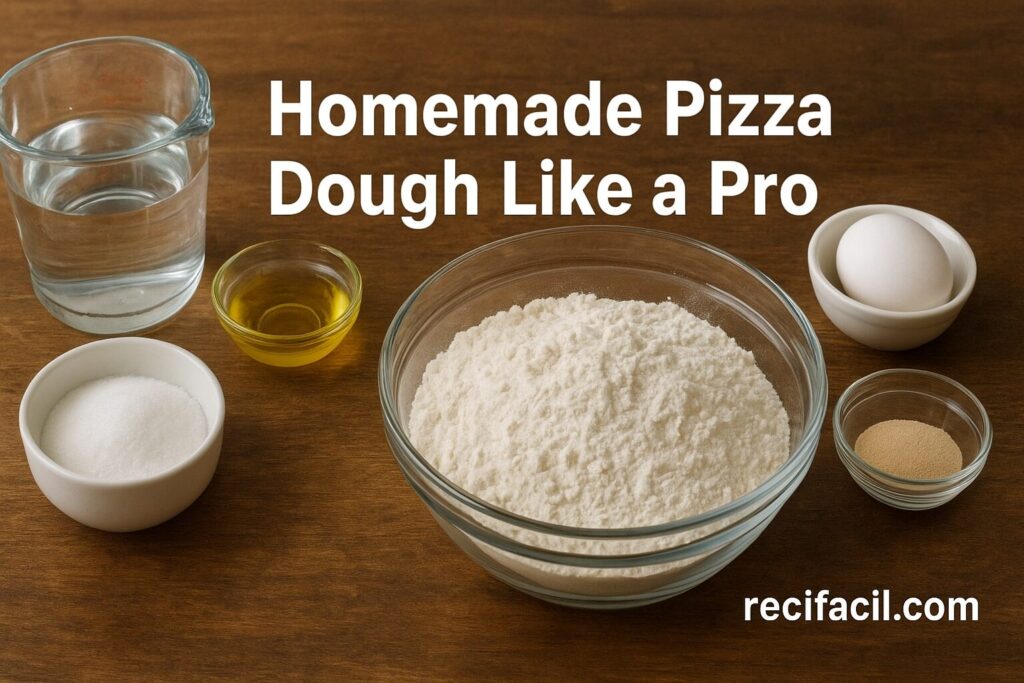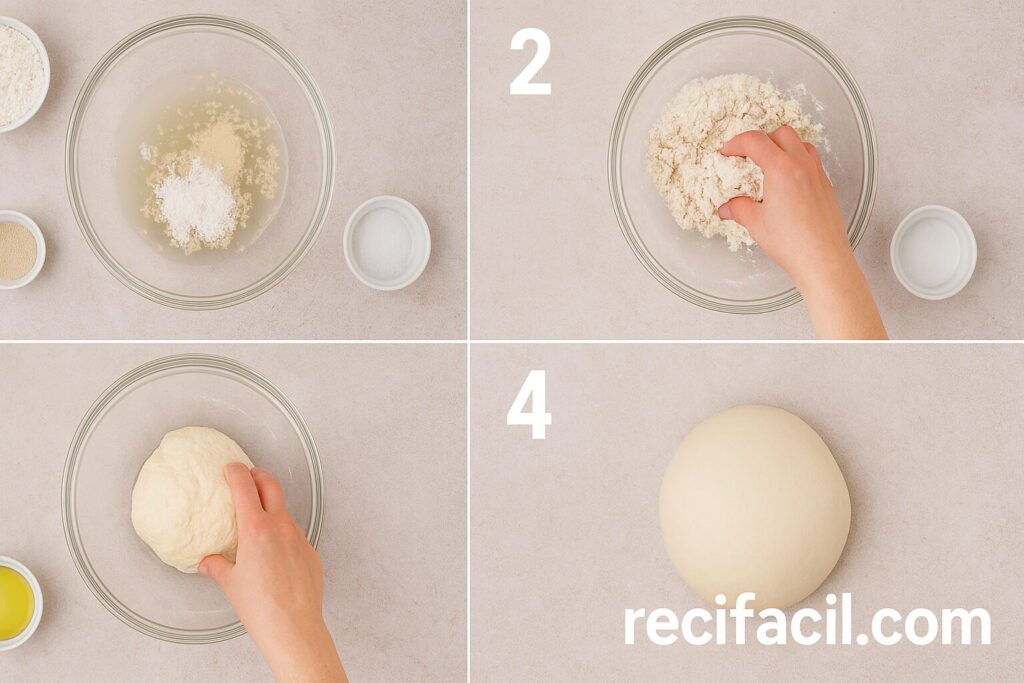Master Homemade Pizza Dough in Just 5 Easy Steps
Making pizza at home doesn’t have to be complicated. With just 5 simple steps, you can create the perfect pizza dough that’s light, airy, and full of flavor—just like the pros! Whether you’re a seasoned chef or a beginner in the kitchen, this recipe will help you master homemade pizza dough in no time. Let’s dive in and turn your kitchen into a pizzeria!

Ingredients for Pizza Dough:
- Flour: 3 ½ cups all-purpose flour (plus extra for dusting)
- Yeast: 1 packet (or 2 ¼ teaspoons) of active dry yeast
- Warm Water: 1 ¼ cups, around 110°F (43°C)
- Sugar: 1 teaspoon (to activate the yeast)
- Olive Oil: 2 tablespoons (for a smooth dough)
- Salt: 1 teaspoon (for flavor)
- Cornmeal: For dusting the pizza peel (optional)
Step 1: Activate the Yeast
Start by dissolving sugar in warm water. Sprinkle the yeast over the water and let it sit for about 5 minutes until it’s frothy. This is the first step in making sure your dough will rise beautifully!
Step 2: Mix the Dough Ingredients
In a large bowl, combine the flour and salt. Once the yeast is activated and bubbly, pour it into the flour mixture, followed by olive oil. Stir the ingredients together until they begin to form a dough.
Step 3: Knead the Dough
Transfer the dough to a lightly floured surface. Knead it for about 8–10 minutes, or until it becomes smooth and elastic. If the dough is too sticky, add a little more flour. The goal is to achieve a soft, smooth dough that springs back when pressed.
Step 4: Let the Dough Rise
Place the kneaded dough into a lightly oiled bowl. Cover it with a damp cloth or plastic wrap. Allow it to rise in a warm spot for about 1–2 hours, or until it has doubled in size.
Step 5: Shape and Bake
Once your dough has risen, punch it down to release the air. Divide it into smaller portions (if desired) and shape them into balls. Roll out each ball on a floured surface to your preferred thickness. Preheat your oven to 475°F (245°C). Add your favorite toppings and bake for about 10-12 minutes until the crust is golden brown.
Tips for Success:
- Flour Choice: For best results, use all-purpose flour, but you can also experiment with bread flour for a chewier crust.
- Rise Time: If you have more time, let your dough rise slowly in the fridge overnight for an even better flavor.
- Toppings: Keep your pizza toppings light and avoid overloading your dough to get a crispier result.
How to Make Homemade Pizza Dough: A Step-by-Step Guide
Making pizza dough at home is a fun and rewarding experience. Here’s a simple, detailed guide to help you create the perfect dough from scratch.

Step 1: Activate the Yeast
Start by activating the yeast. Combine warm water and a bit of sugar. Sprinkle the yeast over the water and let it sit for 5 minutes until it becomes frothy. This shows the yeast is working, which is crucial for the dough to rise.
Step 2: Mix the Dry Ingredients
In a large bowl, mix your flour and salt together. Once the yeast mixture is ready, pour it into the bowl along with a bit of olive oil. Stir everything together until it forms a rough dough.
Step 3: Form the Dough
Once the dough starts coming together, it’s time to knead. Transfer the dough to a clean, lightly floured surface and start kneading. Use your hands to fold and press the dough for about 8-10 minutes. You want the dough to become smooth and elastic. If it feels sticky, add a little more flour, but be careful not to add too much.
Step 4: Let the Dough Rise
Place the dough in an oiled bowl and cover it with a damp cloth or plastic wrap. Let it sit in a warm place for 1-2 hours, or until it doubles in size. The dough needs this time to develop flavor and texture.
Step 5: Shape the Dough
Once the dough has risen, punch it down to release any air bubbles. Then, divide the dough into portions if you’re making multiple pizzas. Roll each portion into a ball, and then stretch or roll it out into a flat circle. You can make the dough as thick or thin as you like.
Step 6: Bake the Pizza
Once you’ve shaped the dough, it’s time to bake. Preheat your oven to a high temperature. Place the dough on a pizza stone or baking sheet and add your favorite toppings. Bake the pizza until the crust is golden brown and the cheese is bubbly.
Step 7: Enjoy Your Homemade Pizza
Once baked, let your pizza cool slightly before slicing. Enjoy your homemade pizza with a crisp, fresh crust!
Extra Tips:
- For a chewier texture, let the dough rise longer or refrigerate it overnight for better flavor.
- If you’re short on time, use the dough as soon as it has risen, but longer rise time usually results in a better texture and flavor.
- To make a crispier crust, preheat your pizza stone before placing the dough on it.
Enjoy the process and the delicious result!
Time, Servings, and Difficulty Level
| Step | Description | Time Required | Servings | Difficulty Level |
|---|---|---|---|---|
| 1 | Mix flour, yeast, sugar, and salt with warm water | 10 minutes | 4 servings | Easy |
| 2 | Knead the dough until smooth and elastic | 8–10 minutes | 4 servings | Medium |
| 3 | Let the dough rise in a warm place | 1–1.5 hours | 4 servings | Easy |
| 4 | Punch down and shape into pizza base | 5–7 minutes | 4 servings | Easy |
| 5 | Add toppings and bake in preheated oven | 12–15 minutes | 4 servings | Easy |

How to Serve and Store Your Homemade Pizza Dough: Tips for Best Results
Making pizza dough from scratch is just the beginning! Now that you have a perfectly made pizza crust, here are detailed tips on how to serve it, store it, and ensure you get the best results every time.
Serving Your Pizza: Tips for the Perfect Experience
Once your pizza is baked and ready, serving it properly is key to maximizing its flavor and texture.
1. Let the Pizza Rest After Baking
- After taking your pizza out of the oven, let it rest for a couple of minutes. This helps the cheese settle and prevents any of the toppings from sliding off when you cut the pizza.
- Allowing the pizza to cool slightly also helps the crust firm up, making it easier to slice.
2. Slice and Serve Immediately
- When slicing the pizza, use a sharp pizza cutter or a large, sharp knife for clean cuts. This prevents the crust from tearing and gives a more polished look.
- Serve the pizza while it’s still warm for the best experience! Freshly baked pizza with a hot, crispy crust and melted cheese is unbeatable.
3. Garnish and Add Fresh Ingredients
- Consider garnishing your pizza with fresh basil, arugula, or a drizzle of olive oil right after baking. These fresh ingredients enhance the flavor and make the pizza look even more appealing.
- If you like, sprinkle a bit of grated parmesan or chili flakes on top to add a kick of flavor.
4. Pair with Beverages
- Homemade pizza goes wonderfully with a range of beverages. For a classic pairing, serve your pizza with a glass of wine or sparkling water. If you prefer non-alcoholic options, iced tea or fresh lemon water works perfectly too.
Storing Your Pizza Dough: Keep it Fresh
If you’ve made extra dough or want to store leftover pizza, follow these tips to keep it fresh for later use.
1. Storing Unbaked Pizza Dough
- If you want to save dough for later, you can freeze it! After you knead the dough, divide it into smaller portions, and wrap each portion tightly in plastic wrap or place it in a resealable plastic bag. Then, store it in the freezer.
- Pizza dough can be stored in the freezer for up to 3 months. When you’re ready to use it, let the dough thaw in the fridge overnight or at room temperature for about 2 hours.
2. Storing Baked Pizza
- If you have leftover pizza, store it properly to keep the crust crispy and the toppings fresh.
- Place the leftover slices on a plate or in a container, and cover them loosely with aluminum foil or wax paper to prevent them from becoming soggy. Avoid using plastic wrap, as it traps moisture, making the crust soft.
- Leftover pizza can be stored in the fridge for up to 3 days. For the best results, reheat it in a hot oven or on a stovetop skillet to restore some of the crispiness.
3. Reheating Leftovers
- To keep the crust crispy when reheating, place your pizza slices on a baking sheet in a preheated oven (around 375°F or 190°C) for about 5-8 minutes. If you don’t have an oven, you can also heat it in a non-stick skillet over medium heat, covering it for a couple of minutes to melt the cheese.
Extra Tips for Serving and Storing Pizza Dough
For Extra Crispiness
- If you love a super-crispy crust, you can bake your pizza directly on a preheated pizza stone. This helps to absorb excess moisture from the dough, making the bottom extra crispy.
- Use a pizza peel or a flat baking sheet to transfer the pizza into the oven to avoid losing heat and ruining the crust’s texture.
How to Make Your Pizza Dough Stretch Further
- If you’re short on time, you can make mini pizzas instead of one large pizza. This is also great for a family pizza night where everyone can add their own toppings.
Keep Dough Fresh for Longer
- If you plan to keep dough in the fridge for a couple of days, cover it tightly with plastic wrap or a lid. It will continue to rise slowly in the fridge, and you’ll get a tastier, more flavorful dough.
Nutritional Information of Traditional Pizza Dough
Homemade pizza dough typically consists of basic ingredients like flour, yeast, olive oil, and salt. Here’s a basic nutritional breakdown of the ingredients in a traditional pizza dough recipe:
| Nutrient | Amount per Slice (1/8 of a pizza) |
|---|---|
| Calories | 150 – 200 kcal |
| Carbohydrates | 30 – 35 grams |
| Protein | 4 – 5 grams |
| Fat | 4 – 6 grams |
| Saturated Fat | 0.5 – 1 gram |
| Monounsaturated Fat | 3 – 4 grams |
| Fiber | 1 – 2 grams |
| Sugar | 1 – 2 grams |
| Sodium | 200 – 300 mg |
| Cholesterol | 0 mg |
| Iron | 1 – 2% of the Daily Value (DV) |
| Calcium | 1 – 3% of the Daily Value (DV) |
Healthy Substitutes for Pizza Dough Ingredients
For those looking to make their pizza dough healthier, there are several substitutions you can use to reduce calories, boost nutrients, or lower carbs.
1. Use Whole Wheat Flour for a Healthier Dough
- Why? Whole wheat flour contains more fiber and nutrients compared to all-purpose flour, making it a better choice for those looking to increase their fiber intake.
- Nutrition: Whole wheat flour adds about 4-5 grams of fiber per slice, which helps with digestion and makes you feel fuller for longer.
2. Try Cauliflower Crust for Low-Carb Pizza
- Why? Cauliflower crust is an excellent choice for those on a low-carb or gluten-free diet. It’s made by finely chopping cauliflower and mixing it with eggs and cheese to form a dough-like texture.
- Nutritional Benefits: This crust is lower in carbs and calories but still provides a satisfying, crispy base for your pizza.
- Tip: Cauliflower crust is a great alternative for people following a keto or low-carb diet, as it cuts the carbs drastically.
3. Swap Olive Oil for Avocado Oil
- Why? Avocado oil is another healthy fat option, packed with heart-healthy monounsaturated fats and antioxidants.
- Nutrition: Avocado oil has a higher smoke point than olive oil, making it a great option if you’re baking at a high temperature. It adds healthy fats without compromising flavor.
4. Add Flaxseed Meal for More Omega-3s
- Why? Adding flaxseed meal to your pizza dough can provide extra omega-3 fatty acids, which are great for heart health.
- How to Add It: You can replace a portion of the flour with flaxseed meal, which will give your pizza dough a slightly nutty flavor and boost the nutritional content.
5. Reduce Salt or Use Sea Salt
- Why? Pizza dough often contains a lot of salt, which can increase the sodium content. Reducing the amount of salt or using a healthier alternative, like sea salt, can help lower sodium levels.
- Tip: Sea salt contains trace minerals and is a less processed option compared to regular table salt, making it a healthier choice.
Other Healthy Alternatives for Toppings and Sauce
Making your pizza healthier doesn’t stop with the dough. You can also make smart choices when selecting toppings and sauce.
1. Use a Tomato-Based Sauce with No Added Sugar
- Why? Many store-bought pizza sauces contain added sugars, which increase the calorie count and spike blood sugar. Choose a tomato sauce that’s low in sugar and high in natural antioxidants like lycopene, which is good for your heart.
- Tip: You can even make your own tomato sauce at home with fresh tomatoes, garlic, and herbs.
2. Go Light on Cheese
- Why? Cheese can be high in fat and calories. To make your pizza healthier, use less cheese or opt for a lower-fat cheese option.
- Healthy Cheese Options: Try using part-skim mozzarella or even vegan cheese made from nuts or soy.
3. Load Up on Veggies
- Why? Vegetables are low in calories and packed with vitamins, minerals, and fiber. Adding more vegetables as toppings is an excellent way to make your pizza healthier without sacrificing flavor.
- Best Veggies for Pizza: Bell peppers, mushrooms, spinach, onions, and tomatoes are all great options.
4. Try Lean Proteins Instead of Processed Meats
- Why? Processed meats like pepperoni and sausage are often high in saturated fats and sodium. Opt for lean protein toppings like grilled chicken, turkey, or tofu for a healthier alternative.
- Tip: Grilled chicken or turkey provides high-quality protein without the extra fat.
Additional Tips for a Healthier Pizza Experience
Use Less Dough
- Why? One of the easiest ways to reduce calories and carbs is by using less dough. Try making a thinner crust to enjoy the pizza without overindulging in calories.
Bake with a Pizza Stone
- Why? A pizza stone helps bake the dough evenly, making it crispier and more enjoyable. This can also help reduce the need for excess oil in the baking process.
Control Portion Sizes
- Why? Pizza can be easy to overeat, but controlling portion sizes ensures that you enjoy your meal without going overboard on calories or fat.
- Tip: Slice your pizza into smaller portions, and pair it with a fresh salad for a balanced meal.
Enjoy Your Homemade Pizza!
There’s nothing quite like the joy of making pizza dough from scratch. Whether you’re creating a crispy, golden crust with simple ingredients or experimenting with healthier alternatives, the process is always rewarding. And the best part? You get to enjoy a fresh, delicious pizza right from your own oven!
So, next time you’re craving pizza, remember: it’s not just about the toppings—it’s about making the dough with love and care. Experiment, have fun, and don’t forget to share a slice with those you love. Happy pizza-making!
📌 Love this recipe? Pin it now and save it for your next lunch craving! Follow us on Pinterest @recifacil for more tasty ideas every week.

